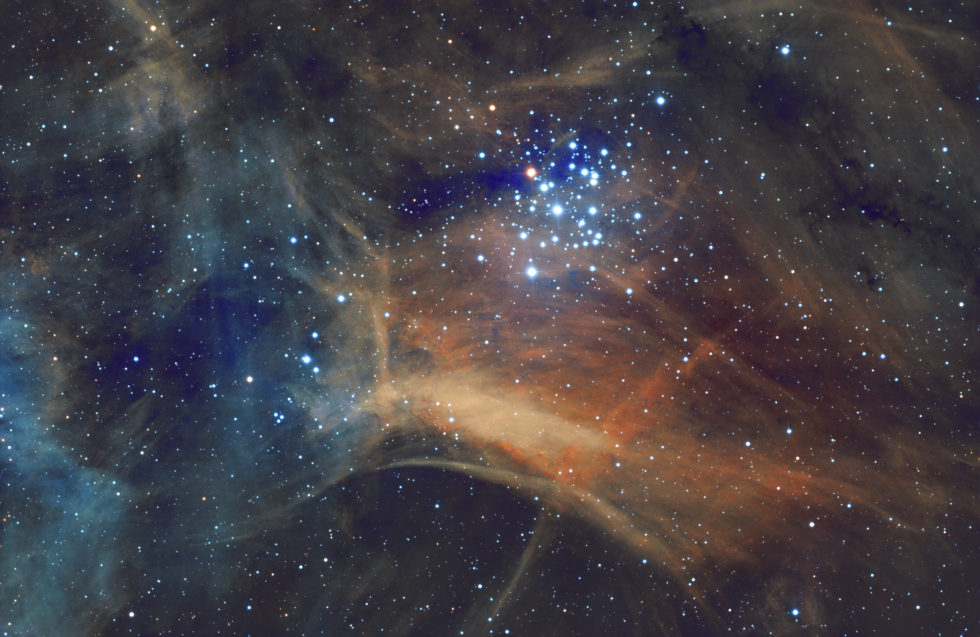NGC3293 The Gem Cluster in SHO
NGC3293 The Gem Cluster in SHO
This is a Telescope Live dataset from the CHI-1 OTA in El Sauce, Chile, imaging took place during June of 2023.
I was experimenting with some new tools/new versions of tools when I processed this dataset. As an open cluster, you might expect the imaging to be in RGB, but this cluster is associated with some significant emission nebula structures. So this dataset was acquired in Narrowband, Ha, Sii, Oiii.
Because of that, I also sought to emphasize the associated nebula rather than tone it back as many have done.
The first new (to me) tool that I tried out was the new (PI process version) of Bill Blankenship's Narrow Band Normalization tool. It worked quite well, and I highly recommend it. However, being new, I was somewhat suspect of the loss of green color band in the initial application. So I went my normal NB route with color masks, etc. What I can say on my testing, is I ultimately wound up in the same place as the NB_Normalization arrived at, it just took more steps. This is on me for not being confident/trusting enough of the tool.
The second tool that I played with (again) was the image merge script developed by Adam Block and friends to merge a Lum Layer with an RGB image. I also do this with narrowband images, with the Ha image being the usual one selected as a substitute for a Lum channel (as I did in this case). I'm beginning to believe that this ImageBlend tool is similar to GHS for stretching - it does better with some image sets than others. In this case I could not quite get to a result that I liked. So I went back to my "normal" process of using the LRGB channel combination tool and got to a good result in just 3-4 iterations.
I used the NB images with a Pixel Math Algorithm shared with me by Uwe Deutermann to create my RGB Stars image. I merged the Stars and Starless images with a PM script for image combination. In between I used the indispensable tools from RC Astro - BlurXterminator, StarXterminator, and NoiseXterminator.
From Wikipedia:
NGC 3293 is an open cluster in the Carina constellation. It was discovered by Nicolas-Louis de Lacaille in 1751. It consists of more than 100 stars brighter than 14th magnitude in a 10 arc minute field, the brightest of which are blue supergiants of apparent magnitude 6.5 and 6.7. There is also a 7th magnitude pulsating red supergiant, V361 Carinae.
NGC 3293 is associated with the open cluster NGC 3324. Both are fairly young, at around 12 million years old. They show some degree of mass segregation, with more massive stars concentrated near their centers. Neither are dynamically relaxed.
I was experimenting with some new tools/new versions of tools when I processed this dataset. As an open cluster, you might expect the imaging to be in RGB, but this cluster is associated with some significant emission nebula structures. So this dataset was acquired in Narrowband, Ha, Sii, Oiii.
Because of that, I also sought to emphasize the associated nebula rather than tone it back as many have done.
The first new (to me) tool that I tried out was the new (PI process version) of Bill Blankenship's Narrow Band Normalization tool. It worked quite well, and I highly recommend it. However, being new, I was somewhat suspect of the loss of green color band in the initial application. So I went my normal NB route with color masks, etc. What I can say on my testing, is I ultimately wound up in the same place as the NB_Normalization arrived at, it just took more steps. This is on me for not being confident/trusting enough of the tool.
The second tool that I played with (again) was the image merge script developed by Adam Block and friends to merge a Lum Layer with an RGB image. I also do this with narrowband images, with the Ha image being the usual one selected as a substitute for a Lum channel (as I did in this case). I'm beginning to believe that this ImageBlend tool is similar to GHS for stretching - it does better with some image sets than others. In this case I could not quite get to a result that I liked. So I went back to my "normal" process of using the LRGB channel combination tool and got to a good result in just 3-4 iterations.
I used the NB images with a Pixel Math Algorithm shared with me by Uwe Deutermann to create my RGB Stars image. I merged the Stars and Starless images with a PM script for image combination. In between I used the indispensable tools from RC Astro - BlurXterminator, StarXterminator, and NoiseXterminator.
From Wikipedia:
NGC 3293 is an open cluster in the Carina constellation. It was discovered by Nicolas-Louis de Lacaille in 1751. It consists of more than 100 stars brighter than 14th magnitude in a 10 arc minute field, the brightest of which are blue supergiants of apparent magnitude 6.5 and 6.7. There is also a 7th magnitude pulsating red supergiant, V361 Carinae.
NGC 3293 is associated with the open cluster NGC 3324. Both are fairly young, at around 12 million years old. They show some degree of mass segregation, with more massive stars concentrated near their centers. Neither are dynamically relaxed.
SPECIFICATIONS
Telescope
CHI-1 (Planewave CDK 24)
Camera
QHY 600M
Location
El Sauce, Chile
Date of observation
June 2023
Filters
Astrodon 3nm Ha, Sii, Oiii
Processing
Pixinsight
Credits
Telescope Live


